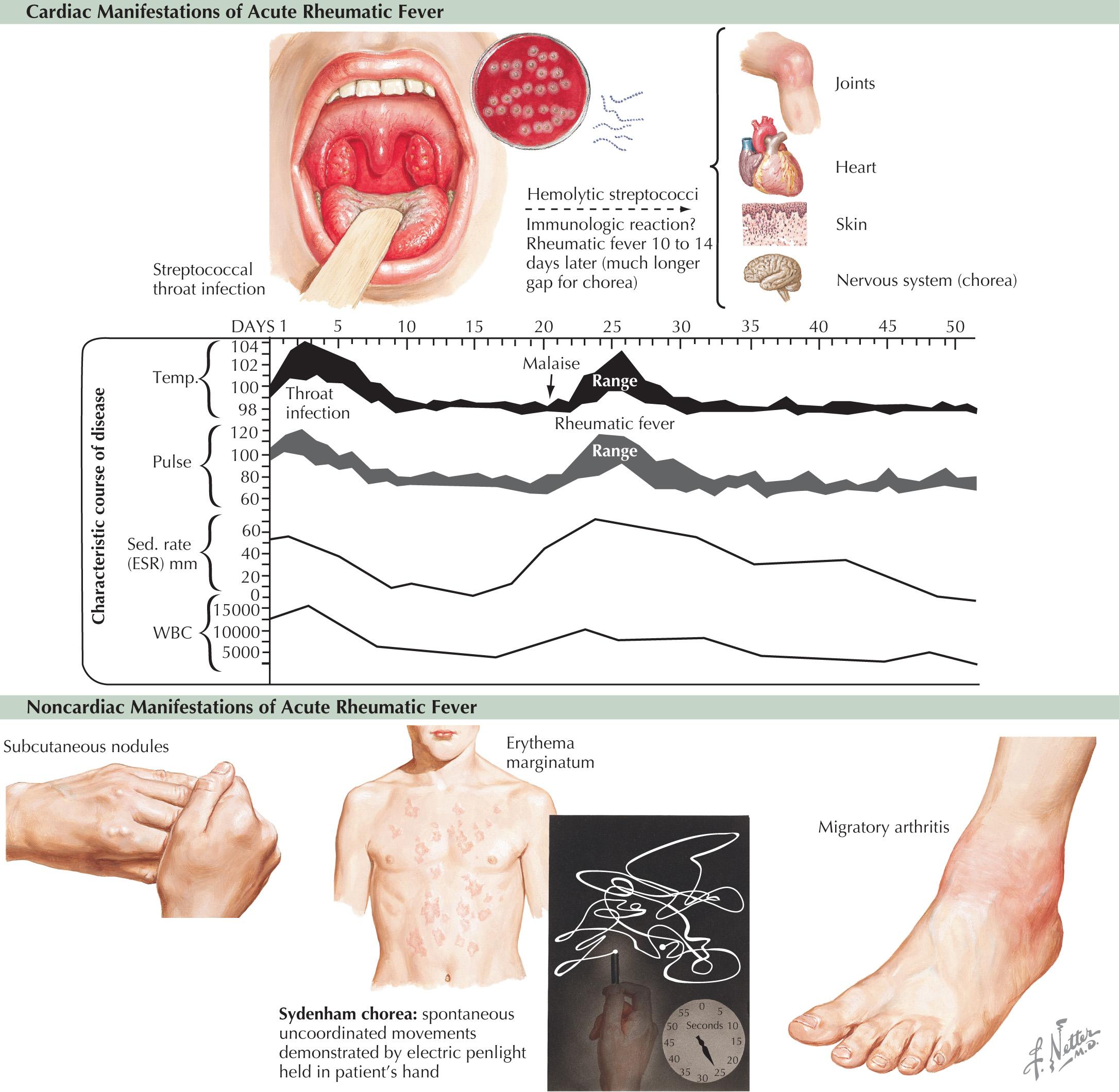Physical Address
304 North Cardinal St.
Dorchester Center, MA 02124
Acute rheumatic fever (ARF), also known as scarlet fever, is caused by an autoimmune reaction to group A β-hemolytic streptococcal pharyngitis, which is caused by the common childhood infection of bacterial streptococcal pharyngitis, also known as “strep throat.” It typically affects children between the ages of 5 and 15 years. Group A streptococcus is a bacteria that lives in oral flora and is spread through contact with droplets from infected persons with cough, sneeze, or touch. ARF is caused by an autoimmune response after exposure to group A streptococcal throat infection. Although not completely understood, the pathogenesis of the autoimmune response appears to be linked to the host's immune reaction to bacterial surface proteins. Streptococcal bacteria have surface proteins, M, T, and R, which are recognized by the host human leukocyte antigen (HLA) class II molecules. The HLA molecules produce antibodies that bind to the bacterial surface proteins, but the antibodies also bind to host proteins through molecular mimicry, which causes an autoimmune reaction. These autoantibodies cause a systemic autoimmune reaction that can interact with the joints, skin, brain, and heart. The autoimmune antigenic mimicry leads to destruction of human heart cardiac proteins that involve the cardiac valvular endocardium. During ARF, carditis and valvulitis can be present but are typically self-limiting. Recurrent or severe bouts of ARF then cause permanent cardiac valve damage, which leads to chronic rheumatic heart disease (RHD). This chapter outlines the evaluation and management of both ARF and chronic RHD.
According to the Centers for Disease Control and Prevention, ARF predominantly affects children between 5 and 15 years old. It begins as a streptococcal throat infection and is characterized by a sore throat with fever and absence of cough ( Fig. 47.1 ). This may also be associated with a red rash that appears on the neck, arm, and groin that then spreads all over the body. The rash is characterized by fine red bumps and feels like sandpaper. The rash lasts for about a week, and then it fades. At that time, the skin around the finger tips and toes may peel. Other common symptoms include an erythematous sore throat, a whitish coating of the tongue, and/or a red and bumpy tongue (strawberry tongue), headaches, swollen glands, nausea, and vomiting.

The earliest symptoms of ARF develop 2 to 3 weeks after the group A strep pharyngitis. These are typically fever and a painful migratory arthritis. Severe cases can manifest as the following: myocarditis, pericarditis, or valvulitis, or combination of the three; erythema marginatum, which are enlarged macular rings or crescent shaped with clear centers; subcutaneous nodules, which are firm nontender nodules over tendons; and Sydenham chorea, an involuntary and irregular movement disorder of the tongue, face, and upper extremities.
Approximately 50% of patients with ARF will develop an autoimmune inflammatory carditis. Acute cardiac manifestations typically occur within 2 to 3 weeks of exposure. Acute rheumatic valvulitis or carditis develops after a few weeks, presenting as persistent sinus tachycardia predominantly at night, a prolonged PR interval, and a pansystolic murmur characteristic of rheumatic valvulitis. Valvulitis occurs in approximately 10% of patients with ARF and is characterized by inflammation and edema of the valve leaflets secondary to autoimmune destruction. Pericarditis is also common in ARF and is characterized by chest pain and a pericardial friction rub.
ARF has a variable presentation that can make diagnosis difficult based on symptoms alone. In patients with arthritis, carditis, and chorea, the differential diagnosis is extensive and includes diseases like Lyme disease, infective endocarditis, Henoch-Schönlein purpura, Kawasaki disease, drug intoxication, Wilson disease, encephalitis, systemic lupus erythematosus, systemic vasculitis, sarcoidosis, and hyperthyroidism. Obtaining a good clinical history, using the Jones criteria, and if possible, a rapid strep titer or transthoracic echocardiogram, can all help differentiate between ARF and other causes of acute systemic illness.
To make a diagnosis of acute ARF, there must be evidence of a preceding streptococcal infection by history or laboratory evidence, whenever possible, including rising antistreptolysin O titers, positive throat culture for group A β-hemolytic streptococci, or a positive rapid group A streptococcal carbohydrate antigen test.
Other laboratory investigations should include a complete blood count, C-reactive protein levels, and erythrocyte sedimentation rate.
Echocardiographic and valvular findings of carditis and/or valvulitis include mitral regurgitation (MR), mitral annular dilation, and elongation of the chordae tendons and nodular leaflet tips. More severe findings include coaptation defects, restricted leaflet motion with prolapse, and in rare cases, chordal rupture.
An echocardiogram is now recommended in all cases of ARF and in cases of possible rheumatic fever. In cases in which ARF meets some of the criteria but not all, an echocardiogram is recommended to look for evidence of subclinical carditis. During the early courses of ARF, the mitral and aortic valves may be normal on echocardiography. Serial echocardiograms should be performed in patients who develop chorea and/or clinical evidence of carditis.
The most common finding on an ECG is sinus tachycardia. In carditis, there may be a prolonged PR interval and occasionally a first-degree heart block.
The initial description of ARF and its symptoms were published in 1944, known as the Jones criteria. These criteria were updated by the American Heart Association in 2015. The diagnosis of ARF primarily falls into the history, physical examination findings, and echocardiographic findings. It includes two sets of criteria: one for low-risk populations, and one for moderate- to high-risk populations. The criteria have also been updated to account for recent evidence to support the use of echocardiography in addition to presentation and examination in making the diagnosis.
See Box 47.1 .
Carditis: clinical and/or subclinical
Polyarthritis
Chorea
Erythema marginatum
Subcutaneous nodules
Polyarthralgia
Fever >38.5°C
ESR >60 mm/h or CRP >3 mg/dL
Prolonged PR interval
Become a Clinical Tree membership for Full access and enjoy Unlimited articles
If you are a member. Log in here